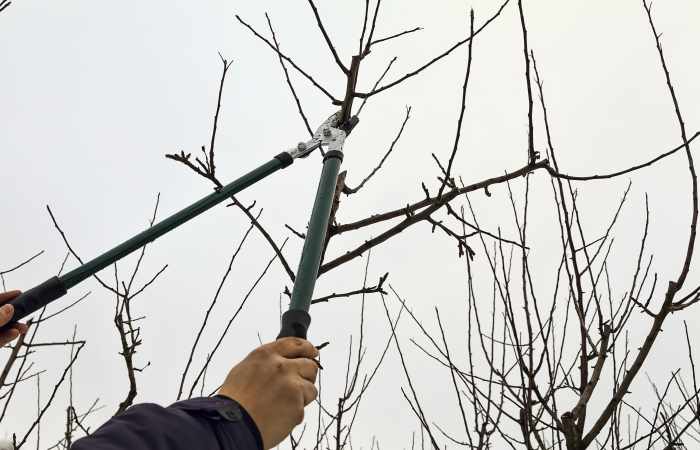Need to cut high tree branches but don’t have the budget to hire a professional tree trimming service?
Don’t worry, by following some safety precautions and using the right tools, just about any homeowner can remove most high tree branches.

In this article, I explain how to cut high tree branches. I include important safety information, the tools you’ll need, and the steps to cut and rope down high tree limbs.
Once you understand the process, you can safely trim those high branches yourself!
Safety For Trimming High Branches
The most common accidents that result from trimming high tree branches are:
- Falling branches
- Electrocution
- Falls from a tree or ladder
With proper care and planning, you can avoid these issues.
Avoid Being Hit By Falling Branches
Even small branches can cause serious injury if they fall on you.
Plot out where the branches that need removal are going to land. Use a rope to lower large and heavy limbs to the ground (a how-to is below.)
Position your body away from the area of impact and keep bystanders far back.
Avoiding Electrocution
Tree limbs that have grown into electrical wires require the services of a tree-trimming professional. Experts have the training and equipment to avoid accidental electrocution.
It’s easy to accidentally touch live wires when using long-handled tools or a tall ladder, so keep your eyes up and tools down when moving about your yard.
Keep in mind that a metal ladder becomes a conduit for a severe shock if a branch anywhere in the tree you are trimming blows against an electrical wire.
It’s also easy for cut branches to fall onto a wire. Never attempt to trim branches that are within fifteen feet of power lines, it’s just not worth the risk!
Prevent Falls
Don’t trim high branches if you’re under the influence of drugs or alcohol.
Make sure ladders have secure footing, and the top doesn’t want to slip or “curl” around the tree trunk, resulting in a fall. Make sure your footwear grips the rungs and have a helper hold the base of the ladder.
Use a harness whenever climbing up a tree.
The small investment you make to own a harness and learn how to use it properly can mean the difference between life and death. Even short-length falls can easily snap bones!
Tools To Cut High Tree Branches
There are many tools to cut high branches while keeping your feet firmly on the ground. Let’s go over the details and uses for each one.
Extendable Pruning Shears
Pruning shears are made to cut through small-diameter branches. The design of extendable pruning shears like those from Fiskars uses a lever action to slice through thinner branches quite easily.
Most pruning loppers or shear models are made to cut through branches up to an inch thick.
Some models require the lever-action to work by pulling on a rope or chain, while others incorporate a sliding mechanism built into the pole.
Related | Best Electric Grass Shears
Extendable Pole Saw/Pruner
Pole saws also incorporate a hook-style pruner blade and trim branches of many thicknesses. You can find extendable pole saws that can reach heights up to 20 feet.
Most models can cut branches up to 1-1/2 inches thick using the pruner tool. For larger branches, you use the curved sawtooth blade to cut the branch.
Telescoping Chain Saw
To trim thick limbs, you’ll need a telescoping chain saw like this Sun Joe model to get the job done.
Most telescoping chain saws are made to extend 10 to 14-feet and to cut branches up to 8-inches thick.
Telescoping chain saws require electrical or battery power.
The tool also requires a bit more strength to hold up the weight of the saw at the end of the long pole during cuts.
How To Cut Tree Limbs That Are Too High To Reach
- Select the branch you wish to cut.
- Determine which tool (pruner, saw, or chainsaw) you need to cut through the diameter of the branch.
- Do a safety check of the tool, and plot out where you expect the branch to fall so you can clear the area.
- Extend and lock the pole to reach the branch you need to cut. Try to position your body so you can cut the branch without it falling directly upon you.
- Cut the branch. You can trim back thin branches anywhere along the length.
When cutting limbs off at the trunk, leave the small “collar” that forms at the base of the branch. This collar helps prevent disease.
To prune with a cutting blade, extend the pole to the length you need. Reach up and hook the branch at the location you wish to cut, then deploy the blade following the manufacturer’s instructions.
For a pruning saw or chainsaw, apply pressure to the blade while cutting. The weight of a thick branch may cause a partially cut limb to bind up on your tool. Try alternating cuts from both sides of the limb to avoid this issue.
How To Rope Down A Tree Limb
For large, heavy branches, it’s wise to rope them off to prevent serious personal injury or damage to property.
Roping off a branch requires getting into the tree via a ladder or climbing. Use a harness or sturdy extension ladder to reach the area of the branch you need to tie off.
Use 1/2-inch thick polyester and nylon rope rated at 500-pounds or stronger. A 200-foot length should be plenty.
Step 1
Locate a strong “support” branch above the branch you plan to remove.
Toss one end of the rope over the support branch, then wrap the line two times around the branch you plan to remove, then back over the support branch and down to the ground.
Use a rolling hitch or clove hitch knot to tie it off to the tree trunk.
Step 2
Have a helper grasp the other end of the rope tight, so there is no slack between the end of the rope and the support branch.
Step 3
Start cutting the branch you wish to remove. Cut up from the bottom one-third of the way through the branch, then finish cutting the rest from the top.
The cut branch should now be hanging by the rope from the support branch.
Step 4
Have the person holding the rope release the pressure and lower the branch to the ground. You can now untie the rope from the tree trunk and unwrap it from the cut branch.
In Summary
Cutting high tree branches is never a task to be taken lightly, but it is a task you can do yourself most of the time.
I hope you found the information in this guide helpful so you know which tools can get tree pruning jobs efficiently.
Add in the proper procedures, equipment, and steps for pruning and roping down branches, you too now know how to cut high tree branches safely.
With your new skills, you can improve the appearance of your landscaping, and avoid calling in those expensive tree trimming services!










